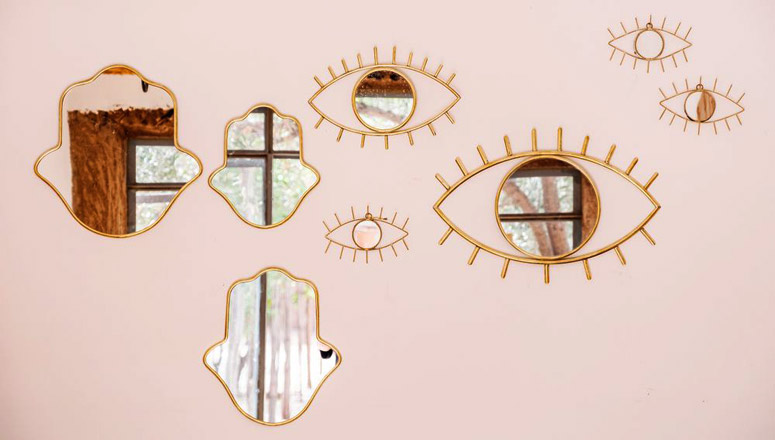Is Fantask-Kitsch the decorating style we need for the moment?
Things are getting serious — too serious, in fact, that we have to pause and make things a little lighter in our homes, “to ward off some kind of ambient gloom, perhaps, at the beginning of this year and after the year 2020 that we have lived through,” says François Delclaux, founder of Un Nouvel Air, at the recent “Digital Days” trends forum at Maison & Objet in Paris.
With an aesthetic that Delclaux calls “Fantask-Kitsch,” an extremely joyful, colorful and humorous offering that he hopes to bring to the home, it’s “a breeze of freshness with accents full of lightness and joie de vivre,” he says.

The Oxford art dictionary defines kitsch as “art, objects or design considered to be in poor taste because of garishness or sentimentality, but sometimes appreciated in an ironic or knowing way.”

The term originated in the art markets of Munich in the 1860s to describe inexpensive paintings or “sketches,” a probable mispronunciation or an elision of the German verb verkitschen, “to make cheap.” The naïve nouveau riche loved these artworks, which they considered typical of “high taste” at prices they could afford.

It was about this time when industrialization made the mass production of cultural goods possible, allowing them to reach a vast number of people. Even peasants and blue-collar workers who were used to traditional forms of culture ended up buying mass-produced décor and knick-knacks.

Mimicking luxury and “high art” but reflecting a childlike simplicity, kitsch became a popular cultural phenomenon. It had more intense, exaggerated features to trigger an emotional response through the fastest and easiest possible way, as opposed to fine art and its subtleties that required more time and cultivation to appreciate.

These features were dependent on expressions of comfort and coziness and a very direct expression of aesthetic pleasure, “aiming for the easiest responses it can get, preferring rather to deliver us back to the comfort of familiar feelings than to challenge us with new ones,” according to Sociology professor Sam Binkley.

Austrian writer Hermann Broch links kitsch to romanticism, which was “a uniquely modern flight from reality into a world that was sheltered from the tension and uncertainty of modern life.”
The German philosopher Walter Benjamin said it “offers instantaneous emotional gratification without the requirement of distance, without sublimation.”

It’s no surprise then that this style seems to be gaining popularity again during these trying times. Kitsch has acquired a certain vintage charm and is a source of amusement.
It doesn’t mean you have to change everything in the home to pastels, of course; just add touches that tease traditional tenets of good taste, all in the spirit of fun, which we so desperately need today.
“Personally, I have seen many new ideas around this kind of aesthetic that I call neo-kitsch,” Delclaux observes. “It’s a kitschy aesthetic but also a little whimsical. The color range is one of fresh pastels but there are also colors that are a little brighter, with an ethnic and artisanal dimension.

It doesn’t mean you have to change everything in the home to pastels, of course; just add touches that tease traditional tenets of good taste, all in the spirit of fun, which we so desperately need today.

“We want to be enchanted by funny objects and certainly unpretentious ones,” according to Delclaux, who singles out the poodle and Siamese cat candleholders as well as twisted pastel picture frames of &Klevering, a Dutch brand we have come across at the M&O shows. He counterbalances these whimsical pieces with floral washi tea boxes from the traditional Japanese studio of Shirotsuki Akazuki.

For the kitchen and dining table, lightness is also achieved with Moroccan tajines from Yadi in soft pastels. Kitsch Kitchen’s “story” plates of old engraving motifs mix merrily with &Klevering’s plates of old-fashioned florals from the late 18th-century tradition of European porcelain and Pied de Poule’s witty pieces like dice egg cups.

“It’s a renewed version of a contemporary cabinet of curiosities with charming little objects in different styles, offering a quirky vision of little messed up things — a blend of influences, patterns and styles that will make you happy with this kind of mix that’s a bit crazy and very humorous,” he says, as he shows cushions in the form of deli items like a Pata Negra leg of ham.

Witty, surreal pieces are also sources of amusement: Ateliers C&S Davoy has gilded frames where you would expect old master paintings but instead you see only empty skies. From the Philippines, Chanalli’s surreal head with an iron will surely bring a smile.

On the ethnic side, Tienda Esquipulas has these flamboyant hearts and Virgin Mary statuettes from South America. The colors are stronger than the pastel-colored décor, but they still give that joyous feeling. Even a jaguar mask from Nest brings an energizing jolt that can snap you out of your lockdown lethargy. You don’t want everything to be soft, after all, and hard-edged, tooth-bearing touches of danger may even ward off all those negative vibrations we want to keep away from our homes.


